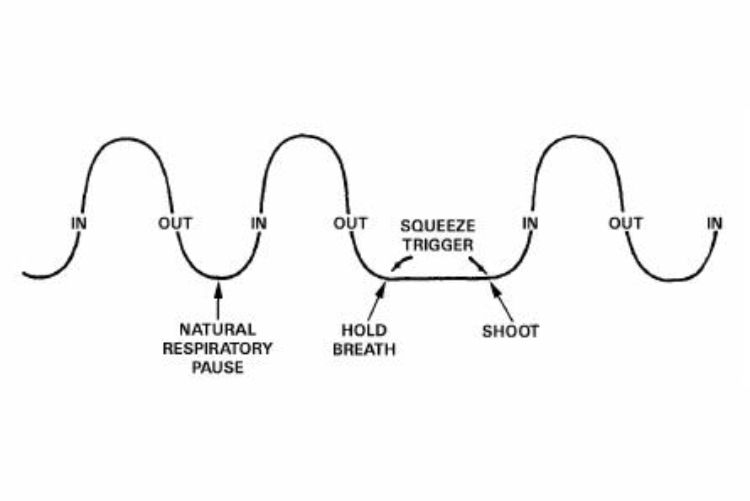
Continuing our journey up the tree of Firearms Fundamentals for shooting technique, we now reach the branches of During the Shot.
Breathing
In the case of long range shooting, it’s important to get a handle on your breathing. Firstly, make sure never to hold your breath while shooting; a held breath causes the body to tremble slightly and these tiny motions can negatively effect your accuracy down range.
Allow your body to breathe normally. If you’re breathing heavily due to exertion or excitement, take a moment to calm yourself and try to slow your breathing to a more normal rate.
In normal breathing there is a slight natural pause at the bottom of your breath, between exhaling and inhaling; this is when you should take the shot.
For those of you who are getting into serious long range shooting technique (1000+ yards), you can also time your shot to happen in the lull between heart beats!
Trigger Control
This is perhaps the most difficult shooting skill to master. When people are struggling to improve their shooting accuracy, poor trigger control is to blame 99% of the time. Flinching often occurs during a trigger press as the body anticipates the loud bang, the recoil, the shockwave etc.
You must regularly practice pressing the trigger on your firearm until you can do it without even the slightest flinch. Dry firing is an excellent way to do this. Most modern centre-fire firearms can be dry fired empty without any detrimental effect, but if you’re worried about it, use quality snap caps.
Most people find that using the pad of their forefinger to press the trigger gives the best results. But others prefer to use the crease behind the first finger joint. Try both methods and pick the one that works best for you.
A good, all round trigger control technique is to press the trigger smoothly and firmly to the rear, as if it was a button.
An old, but effective, trigger control training method, is to balance a small coin on the front sight (or other flat surface near the muzzle) of the gun and then practice dry firing without the coin falling off. It’s harder than it sounds.
Another good technique, which can be used at the range, is to have a shooting partner load a magazine for you and have them insert a dummy round at a random location in the mag. Then video yourself, or have your partner watch you from a safe position while you shoot. At some unpredictable stage while shooting, you’ll encounter the dummy round and you’ll have a click instead of a bang. If the firearm moves on the click, then you are flinching. Use your partner’s observations (or the video) to work out how your flinch is effecting the gun, and practice until you eliminate it.
When shooting at long range, static targets, such as deer hunting, the best way to actuate the trigger is to squeeze it gently. This will allow the shot to surprise you and, therefore, help prevent you from anticipating the shot, or flinching or tensing up.
Of course, the surprise shot technique will not work when shooting at moving targets with a shotgun. In this situation, you must time the shot perfectly so that your projectiles coincide with the path of the target (clay, duck etc.). In this case, tap the trigger firmly to the rear; this will ensure that the gun discharges precisely when you want it to.
As long as you are shooting at a safe and legitimate target, your finger should remain on the trigger all the time. You can also practice releasing the trigger to its reset position, and then pressing it a second time. As soon as you stop shooting, or if the scene becomes unsafe, your finger should come off the trigger and out of the trigger guard.
As with all physical skills, good trigger control will suffer without regular practice, so make sure you don’t neglect it.
We’ve finally reached the top of the tree: After the Shot
Follow Through
Just because you pressed the trigger, and the gun went bang, doesn’t mean it’s time to relax. As with many sports, it’s important to follow through. When you swing a golf club, you don’t stop the swing as soon as the club contacts the ball; instead you follow through and complete a full swing. It’s the same for shooting.
When a firearm has been discharged, it will recoil, lifting the muzzle up, pushing your sights off target and causing you to lose sight picture. You must follow through by keeping a firm grip on the gun and allowing it to settle back on target. You had sight picture before the shot, and you should have sight picture after the shot too.
Follow through is slightly different when using a shotgun on a moving target. Obviously in this case it isn’t practical to obtain sight picture before AND after the shot. Instead, you swing the gun to track a moving target, take your shot, and then you follow through by continuing the swing past the target - but make sure to never allow your gun to swing outside of your safe arc of fire!
It doesn’t matter what type of shooting you’re doing (hunting, target, combat), or what type of firearm you are using (rifle, pistol, shotgun), a good understanding of these fundamentals of safety and marksmanship will help you to be a safer, more proficient shooter.
Eddie Banner is a regular columnist for Calibre. The owner and operator of Instinct Canada, a personal safety, firearms, and first aid training company located on Vancouver Island, British Columbia, Eddie has extensive training and experience with firearms through both professional and private channels, and is an avid outdoorsman.